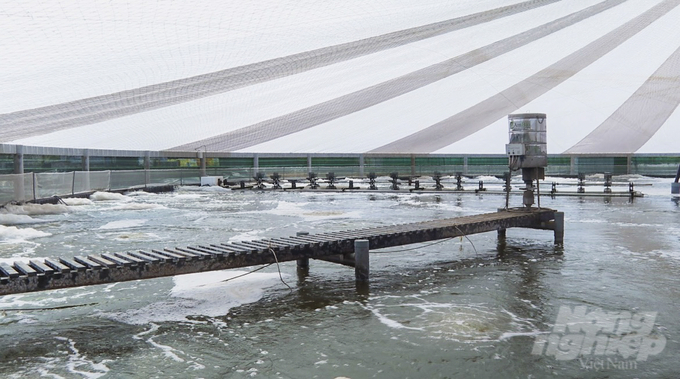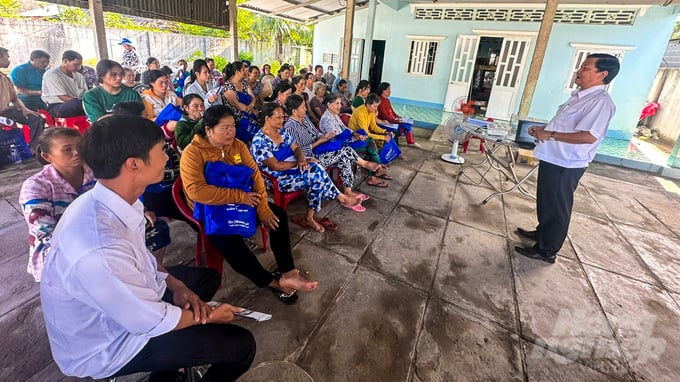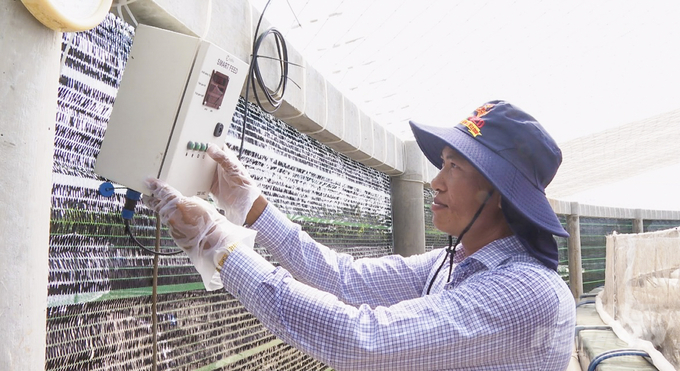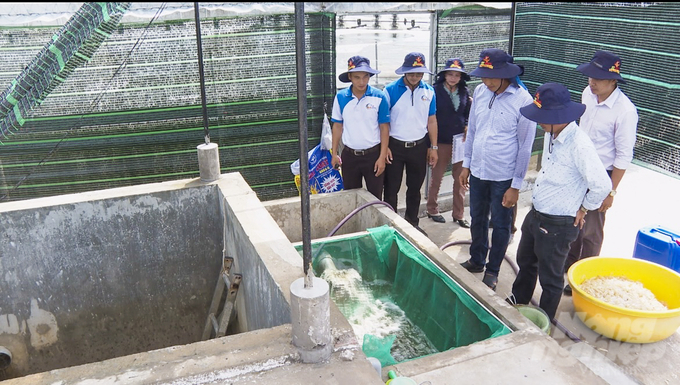November 27, 2025 | 01:36 GMT +7
November 27, 2025 | 01:36 GMT +7
Hotline: 0913.378.918
November 27, 2025 | 01:36 GMT +7
Hotline: 0913.378.918

The automatic feeding floor helps farmers balance the amount of feed for shrimp. Photo: Kim Anh.
The current Soc Trang witnesses a surge of mechanization applications in shrimp farming. Along with using a siphon system to remove pond bottom sludge, waste, and excess food, the pond environment becomes cleaner and more stable. The shrimp has been well cared for and managed throughout the development process in accordance with the motto “prevention is better than cure”.
Nguyen Van Man in Gia Hoa 1 commune (My Xuyen district) is currently applying this model. In the past, farmers mainly based on visual observation and experience to check the pond environment without relying on measuring tools, so the accuracy was not high and the shrimps were susceptible to disease. Now the siphon system helps him accurately identify water quality, detect diseases in shrimp early, which brings about higher production efficiency.
Tran De district is one of the localities strongly developing brackish water shrimp farming in Soc Trang province, with an annual farming area of over 4,500 ha. In the past 2 years, due to erratic developments in the weather, this type of economy is facing difficulties because of epidemics.
Soc Trang Sub-department of Livestock Production and Animal Health recently coordinates with Tran De District Farmer's Union to organize a training program called "Farming techniques and disease prevention for white leg shrimp" for farming households in Trung Binh commune. The goal is to provide basic knowledge about environmental management techniques in shrimp farming as well as disease prevention and treatment measures for farmed shrimp, improving productivity and production efficiency.

Soc Trang Sub-department of Livestock Production and Animal Health coordinates with Tran De District Farmer's Union to organize a training program for local shrimp farmers. Photo: Kim Anh.
Gaining knowledge about techniques for disease prevention and treatment of farmed shrimp is one of the important tasks to minimize damage to the shrimp industry.
According to Director of Soc Trang Sub-department of Livestock Production and Animal Health Lam Minh Hoang, this activity has been integrated into most action programs by the livestock production and animal health sector. The Sub-department also closely coordinates with local authorities to strengthen supervision and control of breed quality, establishing mobile aquatic veterinary testing teams to reach farming areas and support farmers.
To achieve efficiency and productivity, farmers are advised by experts to perform well in pond preparation. Particularly with new ponds, farmers need to properly dig and build the banks, spread lime to treat alum, then pour in water and disinfect the pond. As for old ponds, they need to drain the water, dredge and dry the pond, and reinforce the banks, then spread lime and add water.

It is easy to feed the shrimp nowadays. Farmers can control the system manually by using switches or installing an application on smartphone for remote interaction. Photo: Kim Anh.
Along with the development of science and technology, the majority of shrimp farming households in Soc Trang are very professional in using water environment monitoring equipment or installing automatic monitoring systems. Farmers measure environmental parameters twice a day, in the morning and afternoon, to accurately identify diseases in shrimp.
Statistics from Soc Trang Sub-department of Livestock Production and Animal Health show that feed costs in the province’s shrimp farming scene currently account for 50 - 60% of total investment costs. Therefore, managing and improving the feeding process proves to give a massive boost to the shrimp farming model.

Circulating water treatment system at Truong Ro Sa's shrimp farm. Photo: Kim Anh.
With a farming area of 4.4 ha, Truong Ro Sa in Khu 2 hamlet (Thanh Phu commune, My Xuyen district) is one of the pioneers that apply the rooftop shrimp farming model. He also invests in an automatic feeding floor at each pond. Thanks to that, feed is spread evenly, limiting loss.
Implementing the motto "farm the water first, farm the shrimp after", Ro Sa specially designs a 24/24 automatic water treatment system to help control toxic gases and waste in ponds, ensuring the quality of water supplied to each pond.
Rooftop shrimp farming combined with automatic feeding and water treatment has helped his family limit the impact of environmental factors. Shrimp grows in guaranteed conditions so it reaches a large size when harvested. In two consecutive crops, Ro Sa is able to harvest batches of shrimp with a size of 15 shrimp/kg.
Translated by Samuel Pham
/2025/11/26/4909-2-154329_878.jpg)
(VAN) Pearl grouper farming in HDPE cages not only delivers economic efficiency but also contributes to protecting the environment, creating jobs, and promoting marine-based experiential tourism.

(VAN) The model of making a living under the forest canopy through the agroforestry system in Van Son commune, Bac Ninh province, is expected to generate an annual income of approximately VND 30 million/ha.

(VAN) Many enterprises in Can Tho are harnessing natural energy and reducing greenhouse gas emissions in their production processes, thereby contributing to the promotion of a sustainable green transition.
/2025/11/24/3536-2-112800_176.jpg)
(VAN) Dong Nai now has tens of thousands of hectares of forests certified for sustainable management, and this area will continue to be expanded in the coming period.

(VAN) Vinh Ha hamlet (Dai Xuyen commune, Hanoi) is shifting away from small-scale farming as households adopt bioscurity into their breeder chicken models.

(VAN) Heavy rains make aquatic species more vulnerable to disease. Proactive water management and high-tech systems help farmers prevent outbreaks and protect yields.

(VAN) Greenhouses are shifting production mindsets in Binh Lu commune, enabling farmers to ‘weather the sun and rain’ and secure stable vegetable harvests throughout the year.